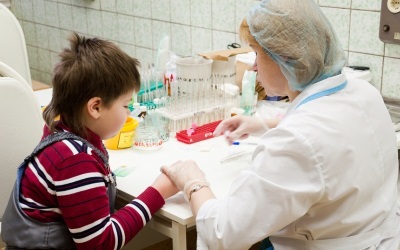Elevated platelet count in a child’s blood
Blood tests are important for assessing the health of children, so their change is always alarming for adults - both mothers and doctors. If parents see in the results of a high content of platelets in the blood of a child, they are always interested in whether it is dangerous for a daughter or son. For timely help, your baby needs to find out why platelets can be above the norm and what to do with an elevated rate.
What number of platelets is considered elevated
Platelets are called small blood cells without nuclei, the second name of which is "blood plates." They are important for blood clotting, in particular, for the formation of blood clots, to close the damage to the vessel and stop the bleeding. Such cells are formed in the red bone marrow, live up to ten days, after which they are destroyed in the spleen.
The upper limit of the norm for a newborn is 490 x 109 / l of platelets, but by the fifth day of life their number begins to decline, being no more than 400 x 109 / l from the age of 5 days to a month, and a maximum of 390 x for a one-year-old child 109 / l.
A slight excess is not considered dangerous by doctors, but if the number of platelets exceeded the norm by 20-30 x 109 / l or more, this condition is called thrombocytosis or thrombocythemia.

Causes of thrombocytosis
Depending on the provoking factor, thrombocytosis is divided into:
- Primary. Its appearance is due to impaired blood platelet formation in the bone marrow, for example, due to a tumor process.
- Secondary. Such an increase in platelets develops due to a disease that does not affect the bone marrow. However, it is only one of the symptoms of the disease.
The causes of secondary thrombocytosis include:
- Surgery to remove the spleen. Increased platelets after such an intervention is associated with a slowdown in their decay. In addition, normally the spleen produces compounds that inhibit the synthesis of platelets, and after removal they cease to restrain their production.
- Acute inflammation, for example, with bacterial or viral infections, rheumatism, tuberculosis, osteomyelitis, and other pathologies. Due to the inflammatory process, the production of the hormone thrombopoietin begins, which stimulates the maturation of platelets.
- Cancers, for example, lymphogranulomatosis or lung sarcoma. Due to the growth of a malignant neoplasm, the bone marrow is activated, with the result that the blood plates are produced in an increased amount.
- Blood loss caused by injuries, cirrhosis of the liver, anemia (both iron deficiency and hemolytic), ulcerative lesions of the gastrointestinal tract, and other factors. In such situations, thrombocythemia is the response compensatory response.
A slight increase in platelet count can be observed during mental or physical overload. Sometimes platelets increase as a result of the side effects of certain medications.
Symptoms of platelet elevation
If the child has developed thrombocytosis, it can manifest itself:
- Swelling and heaviness in the limbs.
- Soreness in fingertips.
- Itchy skin.
- Weakness
- Cyanosis of the skin of the extremities, as well as the lips.
- Cool to the touch with your hands and feet.
- Dizziness.
- Frequent bleeding from the nose.
Than dangerous thrombocytosis in children
Due to too many platelets, blood clotting is accelerated. Platelets begin to stick together with each other and clog up blood vessels, resulting in the formation of blood clots. Their appearance violates the functions of the internal organs, which is especially dangerous if the vessels of the heart or brain are blocked.
Diagnostics
The change in the number of platelets is determined during the clinical analysis of blood. When a child’s thrombocytosis is detected, it should be carefully examined, since the cause of the disease is a fundamental factor in prescribing treatment. If the figure is significantly overestimated, the child should:
- Determine the amount of iron in the blood, as well as the level of ferritin, to eliminate anemia.
- Determine serumucoid and C-reactive protein in the blood to confirm the presence of the inflammatory process.
- To make the analysis of blood clotting.
- Conduct an ultrasound study of internal organs.
- Do a urine test.
In the case of a child's testimony, he is referred to a hematologist, and after his consultation, a bone marrow examination may be prescribed.
Treatment
In the treatment of primary thrombocytosis, cytostatic drugs are used, drugs to improve blood circulation, as well as drugs that prevent blood plates from sticking together. In some cases, prescribed anticoagular and other means.
In severe thrombocythemia, the child is referred for thrombocytopheresis procedure, when the blood plates are removed from the blood with a special device. If thrombocytosis is secondary, attention is paid to the treatment of the underlying disease, and also to protect the child from increased thrombosis.
What to do with a slight increase
If platelets are only elevated slightly, medications are not prescribed. In such situations, the doctor will advise to pay attention to the balanced nutrition of the child. In the children's diet should include:
- Products with a lot of iodine. These include fish and seafood.
- Calcium rich foods. First of all, these are dairy products.
- Products from which the child will receive iron. This may be meat, liver, cereals, fruits, etc.
- Products that help thin the blood. This action has a lemon, ginger, cranberry, viburnum, cowberry, garlic, beets, tomato juice, fish fat and some other products.

It is desirable to avoid food that enhances clotting, for example, bananas, lentils, walnuts, rose hips, pomegranates. In addition, the child should be given a sufficient amount of fluid, and any folk remedies in children with thrombocytosis can be used only after consultation with the doctor.
You can find out more about platelets, their role and normal blood levels by watching the following video.














